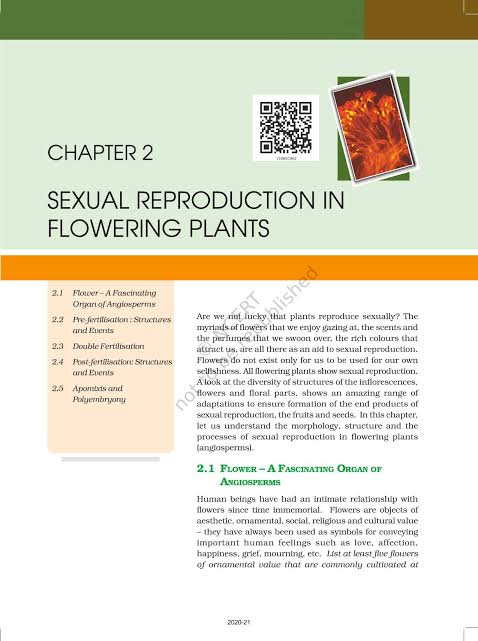Chapter 2 of Class 12 Biology, “Sexual Reproduction in Flowering Plants,” delves into the complex process of reproduction in angiosperms. The chapter begins by introducing the structure of a typical flower, which is the reproductive unit in flowering plants. It discusses the essential parts of a flower, including the androecium (male reproductive organ) and gynoecium (female reproductive organ).
The chapter explains the formation and development of male and female gametophytes. The male gametophyte, or pollen grain, develops in the anther, while the female gametophyte, or embryo sac, develops within the ovule in the ovary. The process of microsporogenesis and megasporogenesis, which lead to the formation of pollen grains and embryo sacs respectively, are also discussed.

Class 12 Biology Chapter 2 Sexual Reproduction in Flowering Plants Book 📚 download PDF files 👇👇👇
Pollination, the transfer of pollen from anther to stigma, is a key topic in the chapter. Various modes of pollination, including self-pollination and cross-pollination, along with agents of pollination like wind, water, and insects, are covered in detail.
Post-pollination events, such as pollen tube formation, double fertilization (where one sperm fertilizes the egg forming the zygote and the other sperm fuses with two polar nuclei to form the triploid endosperm), and the development of the seed and fruit are crucial aspects of this chapter.
The chapter concludes with a discussion on apomixis and polyembryony, phenomena where seeds develop without fertilization, and multiple embryos are formed in a single seed, respectively. Understanding these processes is vital as they have significant implications in plant breeding and agriculture.
Long Answer Questions
Describe the structure of an ovule. Explain the process of megasporogenesis.
Answer: The ovule is the female reproductive structure found within the ovary of a flower. It consists of an integumented megasporangium that encloses the nucellus, where the embryo sac (female gametophyte) develops. Megasporogenesis is the process of formation of megaspores from the megaspore mother cell (MMC). The MMC undergoes meiosis to produce four haploid megaspores, of which typically one survives and develops into the embryo sac.
Explain the process of double fertilization in flowering plants.
Answer: Double fertilization is a unique process in flowering plants where two sperm cells from a pollen grain fertilize cells in the ovule. One sperm cell fertilizes the egg cell, forming a diploid zygote, while the other fuses with the two polar nuclei to form a triploid endosperm, which nourishes the developing embryo.
Discuss the various types of pollination and the adaptations plants have for cross-pollination.
Answer: Pollination can be of two types: self-pollination (within the same flower or between flowers on the same plant) and cross-pollination (between flowers of different plants). Cross-pollination promotes genetic diversity and is facilitated by adaptations such as dioecy, herkogamy, dichogamy, and self-incompatibility.
Describe the formation of a seed and the stages of embryo development in flowering plants.
Answer: After fertilization, the ovule develops into a seed. The zygote undergoes mitotic divisions to form an embryo, which includes the radicle, plumule, and cotyledons. The integuments of the ovule become the seed coat, and the ovary develops into the fruit.
Explain the significance of apomixis and polyembryony in plants.
Answer: Apomixis is the formation of seeds without fertilization, ensuring clonal reproduction of plants. Polyembryony is the development of multiple embryos from one ovule, leading to the production of more than one seedling from a single seed, which can be beneficial for the propagation of certain plant species.
What are the different stages of pollen grain development?
Answer: Pollen grain development begins with microsporogenesis, where microspore mother cells in the anther undergo meiosis to form haploid microspores. Each microspore develops into a pollen grain containing two cells: the generative cell (which forms sperm cells) and the tube cell (which develops into the pollen tube).
Discuss the role of endosperm in seed development.
Answer: The endosperm provides nourishment to the developing embryo within the seed. It is formed as a result of the fusion of a sperm cell with the polar nuclei, creating a triploid tissue that stores nutrients.
What are the adaptations for wind pollination in plants?
Answer: Wind-pollinated plants have adaptations such as lightweight, small, and numerous pollen grains; long and feathery stigmas to catch pollen; and often reduced or absent petals since they do not rely on attracting pollinators.
How does the structure of a flower contribute to its reproductive success?
Answer: The structure of a flower, including the arrangement of stamens and pistils, the presence of nectar to attract pollinators, and the protection provided by petals, all contribute to efficient pollination and fertilization, ensuring reproductive success.
What is the importance of genetic diversity in sexual reproduction of plants?
Answer: Genetic diversity, achieved through sexual reproduction, allows plant populations to adapt to changing environments, resist diseases, and improve survival chances, ensuring the long-term success of the species.
Short Answer Questions
What is self-incompatibility?
Answer: Self-incompatibility is a genetic mechanism in plants that prevents self-pollination and promotes cross-pollination, thereby maintaining genetic diversity.
Define pollination.
Answer: Pollination is the transfer of pollen grains from the anther (male part) to the stigma (female part) of a flower, enabling fertilization.
What is a pollen-pistil interaction?
Answer: Pollen-pistil interaction refers to the complex process of recognition and rejection or acceptance of pollen grains by the pistil, leading to successful fertilization or inhibition.
What are the main functions of the fruit in plants?
Answer: Fruits protect seeds, aid in their dispersal, and sometimes provide nourishment to the developing seedling.
Describe the process of microsporogenesis.
Answer: Microsporogenesis is the formation of microspores from microspore mother cells through meiosis, which then develop into pollen grains.
What is the role of the pollen tube in fertilization?
Answer: The pollen tube carries the sperm cells from the pollen grain to the ovule, facilitating fertilization.
How does cross-pollination occur in plants?
Answer: Cross-pollination occurs when pollen from one plant is transferred to the stigma of a flower on a different plant, often aided by wind, water, or pollinators.
What is the significance of endosperm in seed plants?
Answer: The endosperm provides essential nutrients to the developing embryo, supporting its growth.
Explain the term ‘embryo sac’.
Answer: The embryo sac is the female gametophyte within the ovule of a flowering plant, containing the egg cell and other nuclei necessary for fertilization and seed development.
What is the function of integuments in ovules?
Answer: Integuments protect the ovule and later develop into the seed coat after fertilization.

Get involved!
Comments